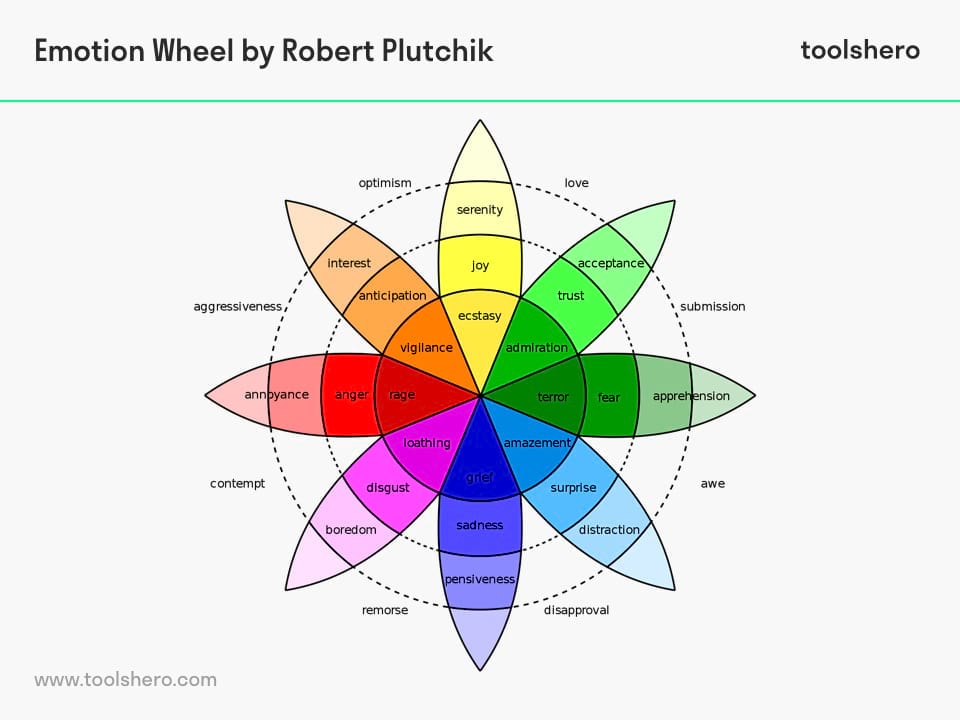Wheel of Emotions (Plutchik) explained

Wheel of Emotions: this article explains the Robert Plutchik’s Wheel of Emotions in a practical way. This article explains a basic theory of the concept, the elements and dimensions and a visualized example of the Wheel of Emotions. After reading it, you will understand the basics of this powerful Personal Happiness theory. Enjoy reading!
What is the Robert Plutchik’s Wheel of Emotions? The theory and background
The Wheel of Emotions was developed by the American psychologist Robert Plutchik in 1980 as a visual tool for understanding his psycho-evolutionary theory. He identified eight primary emotions in polar opposite pairs.
- Joy vs. Sadness
- Trust vs. Disgust
- Fear vs. Anger
- Anticipation vs. Surprise
The Wheel of Emotions can be used to navigate between the various intensities that emotions bring along and evoke. As such, the Wheel is primarily useful for objectively identifying intense feelings and emotional states. Robert Plutchik’s research showed that there are 34,000 distinguishable, specific emotions.
However, it is actually impossible to differentiate and understand all 34,000 emotions. By reducing these to eight primary emotions, things become a little simpler. The model helps to develop emotional understanding and emotional intelligence. Robert’s Plutchik’s Wheel is often referred to as the theory of emotion.
Robert Plutchik
Robert Plutchik is also most well-known for his research on emotions and the development of the wheel of emotions. Emotions were one of Robert Plutchik’s main areas of interest for research. The research interests of Robert Plutchik included the study of suicide, violence and psychotherapy. Robert Plutchik was an established professor and psychologist.
Elements within Robert Plutchik’s Wheel of Emotions
The Wheel of Emotions has three elements which also act as its three main characteristics:
1: Colours
The eight basic emotions have each been marked with a recognisable colour within the Emotion Wheel. As the intensity of the emotion increases, so does the intensity of the colour. However, combinations of two basic emotions are not given a colour.
2: Layers
The Wheel of Emotions has different layers and dimensions. Towards the middle of the Wheel, the intensity of the emotion and colour increases.
3: Relations
The Feelings Wheel of Emotions depicts mutual relations found in between opposing emotions. Combinations of emotions that arise when emotions are mixed together are found in between the basic emotions. As a result, all emotions are in mutual contact with one another.
Robert Plutchik’s Wheel of Emotions Chart
The eight core emotions form the basis for all other human emotions. The eight primary emotions are entered into a grid opposite one another.
After all eight emotions are connected to one another, a wheel is created (hence the name of this model). The Wheel of Emotions has been constructed such that every emotion has its own colour.
As the intensity of the emotion increases (towards the centre of the wheel), so does the indicator colour. Both the emotion and the color decrease towards the outer edge. There are also secondary emotions that are presented as combinations of the primary emotions.

Figure 1 – Robert Plutchik’s Wheel of Emotions
Wheel of Emotions Dimensions
The wheel of emotions can be displayed in both two and three dimension. In the flat, two-dimensional Wheel, there are eight segments, in which the primary emotion dimensions are located: anger, anticipation, joy, trust, fear, surprise, sadness and disgust.
Each segment has an opposing emotion, and also has its own colour within the Wheel of Emotions. The emotions without colours represent mixtures of two primary emotions. For example, Anticipation and Joy are combined to create Optimism.
In its three-dimensional form, the Wheel of Emotions becomes a conical shape. This vertical dimension focuses on the intensity of the emotion, which becomes stronger the more it moves inwards.
So, the emotion of ‘boredom’ can, if it is not kept in check, develop into the more intense emotion of ‘disgust’, and ‘anger’ can flare up and become ‘rage’. This immediately teaches people how to deal with emotions in real-world situations in relation to each other; if emotions are not controlled, they can run high and become more intense.
Robert Plutchik’s Wheel of Emotions : basic assumptions
Robert Plutchik’s Wheel of Emotions theory is rooted in ten basic theoretical assumptions that can be found below:
1: Animal & human
The basic emotions are the same for humans as they are for all other mammals, and are generated in the middle-most part of the brain: the limbic system.
2: Evolution
Emotions arose during the evolutionary process and continued to develop in humans. This has resulted, in addition to the eight basic emotions, in 34,000 different discernible emotions.
3: Survival
The eight basic emotions play a role in human survival. Fear, which warns us of dangerous situations, is a good example.
4: Basic patterns
Every basic emotion has a number of common, recognisable patterns and elements that are also called prototypes.
5: Basic emotions
Robert Plutchik identifies eight basic emotions that humans as well as mammals have in common: anger, anticipation, joy, trust, fear, surprise, sadness and disgust.
6: Combinations
The combinations of eight basic emotions produce new emotions, whereby ‘joy’ and ‘trust’ can lead to ‘love’, for example.
7: Constructs
According to Robert Plutchik, emotions are hypothetical constructs or ideas that help describe a specific experience.
8: Opposites
Polar opposites and duality are common in nature, as is reflected in the basic emotions: Joy vs. Sadness, Trust vs. Disgust, Fear vs. Anger, Anticipation vs. Surprise.
9: Similarity
In addition to duality, there are also emotions that share commonalities.
10: Intensity
Every emotion has degrees, from diminished to fiercely intense.
Application of Wheel of Emotions
The wheel of emotions makes it possible to simplify incredibly complex emotional concepts.
The wheel of emotions can be used to visualise emotions, giving one an insight into the combinations of emotions and their implications. By objectively describing emotions, it is possible to get a better handle on certain (difficult) situations.
You can make use of the Wheel of Emotions in different situations. As the wheel of emotions mainly helps to improve understanding of your emotions, is can prove useful when you are confronted with a problem.
Many people can process and experience their emotions subconsciously. This makes it difficult to understand what we feel exactly in a given situation. The Wheel of Emotions helps break down complex emotions to the eight core emotions. By simplifying your emotions, it can become clear how you should act or behave.
Expansion of the Wheel of Emotions
Robert Plutchik expanded on the Wheel of Emotions by adding defence mechanisms to the eight core emotions. These defence mechanisms were proposed to be possible manifestations of the eight core emotions of the Wheel of Emotions.
These defence mechanisms were explained by a stimulus or event leading to an inferred cognition and, in turn, to feeling one of the core emotions of the Wheel of Emotions. These emotions then stimulate a certain behavior which leads to the desired effect.
It’s Your Turn
What do you think? Have you ever heard of the Robert Plutchik’s Wheel of Emotions? Do you recognize the practical explanation or do you have more suggestions? What are your success factors for personal happiness and well-being? Do you often show emotional responses in life?
Share your experience and knowledge in the comments box below.
More information
- Plutchik, R. (1984). Emotions: A general psychoevolutionary theory. Approaches to emotion, 1984, 197-219.
- Plutchik, R. (2001). The nature of emotions: Human emotions have deep evolutionary roots, a fact that may explain their complexity and provide tools for clinical practice. American scientist, 89(4), 344-350.
- Scherer, K. R., Shuman, V., Fontaine, J. R., & Soriano, C. (2013). The GRID meets the Wheel: Assessing emotional feeling via self-report. Components of emotional meaning: A sourcebook, 281-298.
How to cite this article:
Mulder, P. (2018). Wheel of Emotions (Plutchik). Retrieved [insert date] from Toolshero: https://www.toolshero.com/psychology/wheel-of-emotions-plutchik/
Original publication date: 03/14/2018 | Last update: 05/10/2023
Add a link to this page on your website:
<a href=”https://www.toolshero.com/psychology/wheel-of-emotions-plutchik/”>Toolshero: Wheel of Emotions (Plutchik)</a>













2 responses to “Wheel of Emotions (Plutchik) explained”
I have a question…what if you are drawn to the opposing color your body needs for healing? Are you trying to balance the excessive energy of the needed color?
The emotion wheel shown (Robert Plutchik’s) is interesting and useful. However, it’s missing many common sensations we all experience throughout life, such as compassion, hunger, and so on. I’d suggest to check out the Pan-Affect Chart, which aims to better cover all of our pleasant and unpleasant feelings (without going too overboard). Cheers, Pierre.